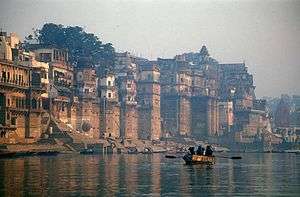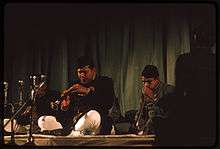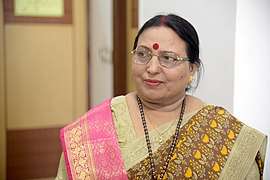Bhojpuri region
The Bhojpuri region or Bhojpur is an area encompassing parts of the states of Bihar, Jharkhand, and Uttar Pradesh in northern India where the Bhojpuri dialect of Hindi is spoken as the mother-tongue. The Bhojpuri region is bordered by Awadh in the west and Mithila in the east. Ujjainiya Rajputs of the former Shahabad district of ancient Bihar established their headquarters in the town of Arrah, Bhojpur district from where the whole region received its name.[1]

Culture
The economic and industrial growth of this region had been greatly hindered because of caste-guided political in-fighting and a huge population.[2] The culture of Bhojpur is also very much present today in Trinidad and Tobago, Guyana, Suriname, Fiji, Mauritius, and South Africa, due to the many Indian indentured laborers who were sent there by the ruling British in the mid 19th century to the early 20th century, and were from the Purvanchal-Bhojpur region.
Music
The Classical music in Bhojpur is a form of the Hindustani classical music. Bhojpur has produced great poets and musicians like Bhikhari Thakur, Bharat Ratna Ustaad Bismillah Khan, etc.
Some of the major folk songs in Bhojpuri region are Kajari, Thumri, Sohar, Chhath Songs, Chaiti, Alha, Barahmasi, Phaag, Birha and Kaharwa.
Sharda Sinha, Girija Devi, Malini Awasthi, Manoj Tiwari, Chandan Tiwari, etc. are the famous Bhojpuri folk singers.
Dance Kathak, Kajri, Jhumair, etc. are the major dance forms in Bhojpuri region.
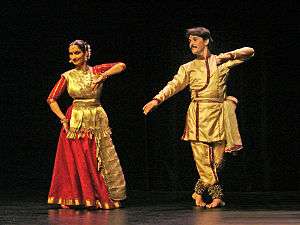
Kathak is one of the eight major forms of Indian Classical Dance. Kathak Dancers tell various stories through their hand movements and extensive footwork, but most importantly through their facial expressions. Kathak evolved during Bhakti Movement, particularly by incorporating the childhood and stories of Hindu God Krishna, as well as independently in the courts of North Indian Kingdoms.
The Kajari Dance is performed along with Kajari song which is a monsoon song. Starting in the month of Shravana, which is the start of monsoon season, the dance is performed till the time rainy season persists. The songs describe the sudden and pleasant change in the nature that has happened and also account the refreshing and relaxing felling that people feel.
Jhumair is a famous folk dance of the Bhojpuri people. With the advent of spring, nature blossoms into a riot of colour and fragrance. The people of this region welcome spring with vibrant songs and dance. This rhythmic dance form is an expression of the joys and sorrows of the people.
Other dance forms in the region include Bideshiya, Domkach, Dhamar Jogira and Launda Naach.
Festivals
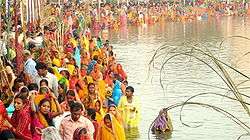
Chhath Puja is the largest festival celebrated in the Bhojpuri region. Chhath also called "Dala Chhath", is an ancient and major Vedic festival. Chhath is the worship of Sun God. On the eve of Chhath Puja, houses and their surroundings are scrupulously cleaned. Then the ritual bathing and worship of Sun God takes place, performed twice: once in the evening once at dawn, usually on the banks of a river, or a common large water body. For several days ritual renditions of regional folk songs are sung. These folk songs have been carried on through oral transmission from mothers and mothers-in-law to daughters and daughters-in-law for generations.
It is one of the oldest festival continuously celebrated since the time of Vedic Period. It is believed that it generally follows the Vedic worship of sun god which is preserved in the region till now and it is celebrated at huge expanse.
After Chhath Puja, Durga Puja is the second major festival of Bhojpuri region. Here it is celebrated for ten days. Different forms of Goddess Durga are worshipped in the festival. Whole cities and villages are decorated with beautiful lights and beautiful pandals are created for this festival.
Holi is celebrated with the same fervour and charm in Bhojpur as in rest part of North India. Here, too the legend of Holika is prevalent. On the eve of Holi people light bonfires and Folk songs are sung at high pitch and people dance to the tune of dholak and the spirit of Holi. On the day of Holi people smear each other with colours and drench each other.
Other major festivals celebrated here are Diwali, Makar Sankranti, Saraswati Puja, Maha Shivratri, Rama Navami, Raksha Bandhan, Teej, Jitiya, Janmashtami, Vishwakarma Puja, Bhai Dooj, Buddha Purnima, Mahavir Jayanti, Eid, Christmas, etc
Districts
Bhojpuri language is spoken in the districts of Western Bihar and Eastern Uttar Pradesh which is called Purvanchal.[3]
See also
References
- Kolff, Dirk H.A. (2002) [First published 1990]. Naukar, Rajput, and sepoy : the ethnohistory of the military labour market in Hindustan, 1450-1850. Cambridge University Press. p. 160. ISBN 0-521-52305-2.
The Bhojpuri region received its name after the town of Bhojpur, the ancient headquarters of the Ujjainiya Rajputs of the erstwhile Shahabad district of Bihar.
- Archived 27 August 2013 at the Wayback Machine
- "Culture of Bhojpuri Region". Archived from the original on 16 April 2009. Retrieved 8 April 2018.. Discover Bihar, official website of Bihar Tourism.
External links
| Wikivoyage has a travel guide for Bhojpur (region). |
